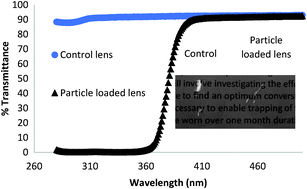Incorporation of ultraviolet (UV) absorbing nanoparticles in contact lenses for Class 1 UV blocking
Abstract
Accumulated UV exposure over long durations could be a contributory factor for ocular complications including cataracts and retinal damage. UV blocking contact lenses offer excellent protection, however, only a few commercial UV blocking contact lenses are available. Thus there is a need to develop new approaches for imparting UV blocking to contact lenses. We incorporate highly UV absorbing nanoparticles into hydroxyethylmethacrylate (HEMA) and silicone hydrogels by polymerizing a mixture of monomers and nanoparticles. The nanoparticles are prepared by thermal free radical polymerization of an emulsion of hydrophobic UV absorbing components that contain a polymerizable vinyl group. The particle size is controlled to be less than 100 nm to minimize the scattering of visible light. The nanoparticles disperse well in the HEMA monomer leading to fully transparent gels with excellent UV blocking. The particle suspension does not disperse in the silicone-hydrogel formulations necessitating dialysis to reduce the surfactant concentration. The silicone-hydrogels loaded with the particles are excellent UV blockers but the transparency in the visible range is only about 60%. SEM imaging of the particle loaded gels show that the microstructure of the gels depend on the rate of polymerization, with a rapid rate leading to a more uniform distribution of the particles. UV blocking from the particle loaded gels is not impacted by processing such as autoclaving. Also UV exposure does not degrade UV absorption and the particles are retained in the lens during storage. Incorporation of nanoparticles into contact lenses by the addition of the polymerization mixture followed by curing is a promising approach for imparting UV protection to contact lenses.


 Please wait while we load your content...
Please wait while we load your content...